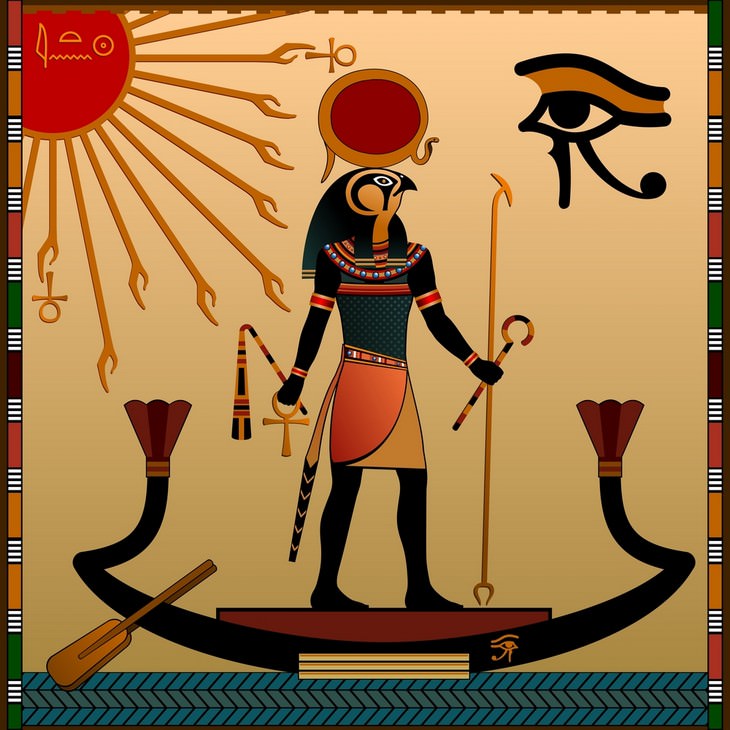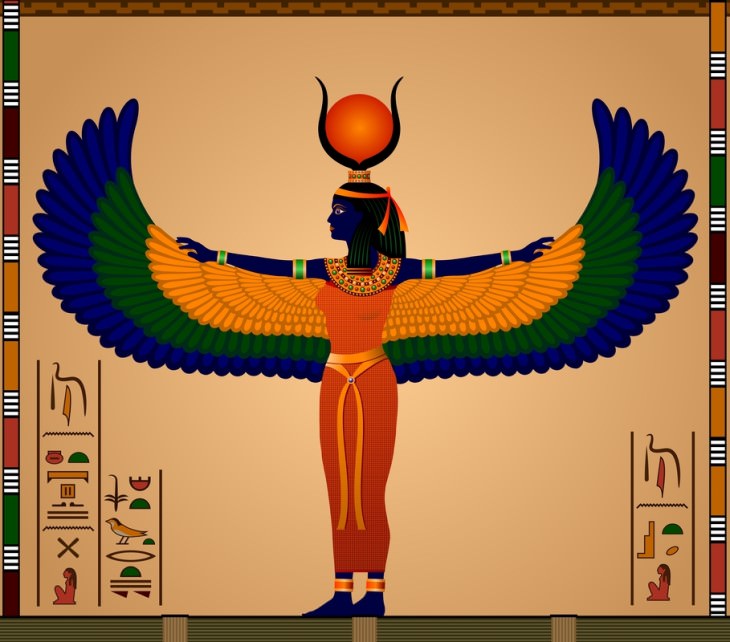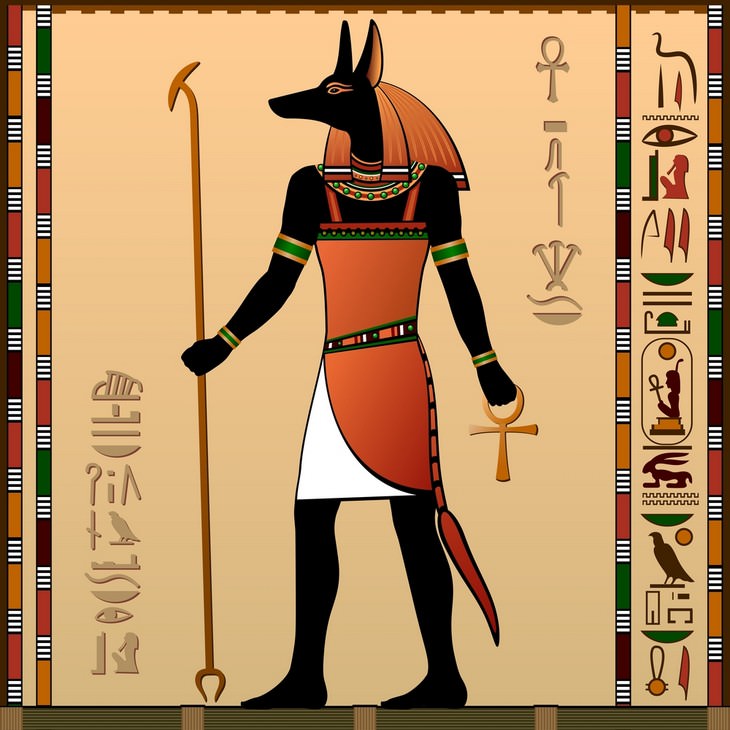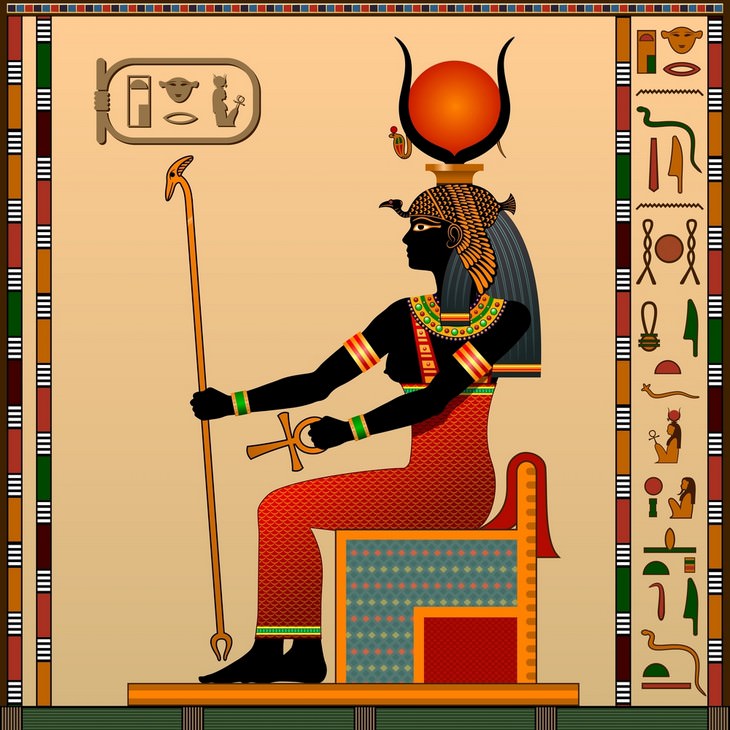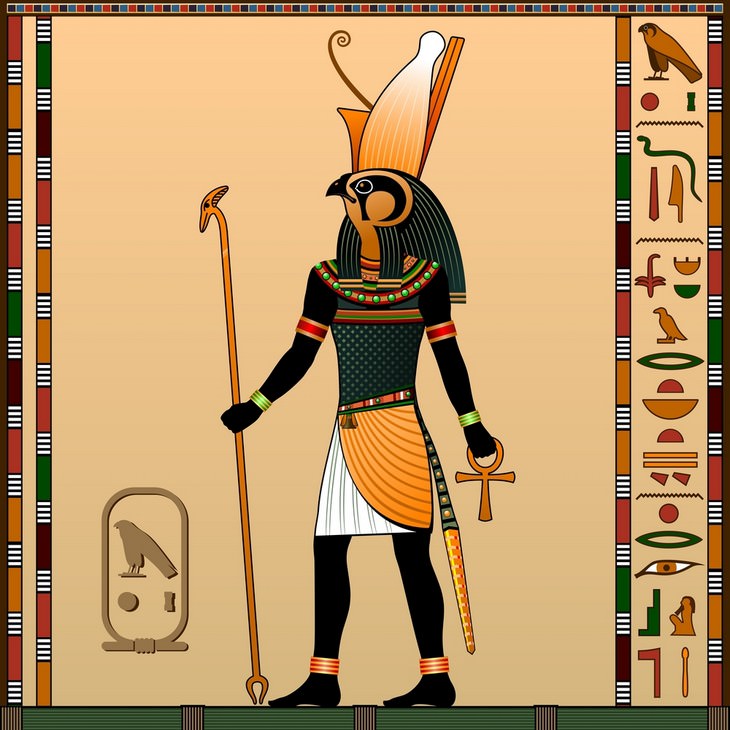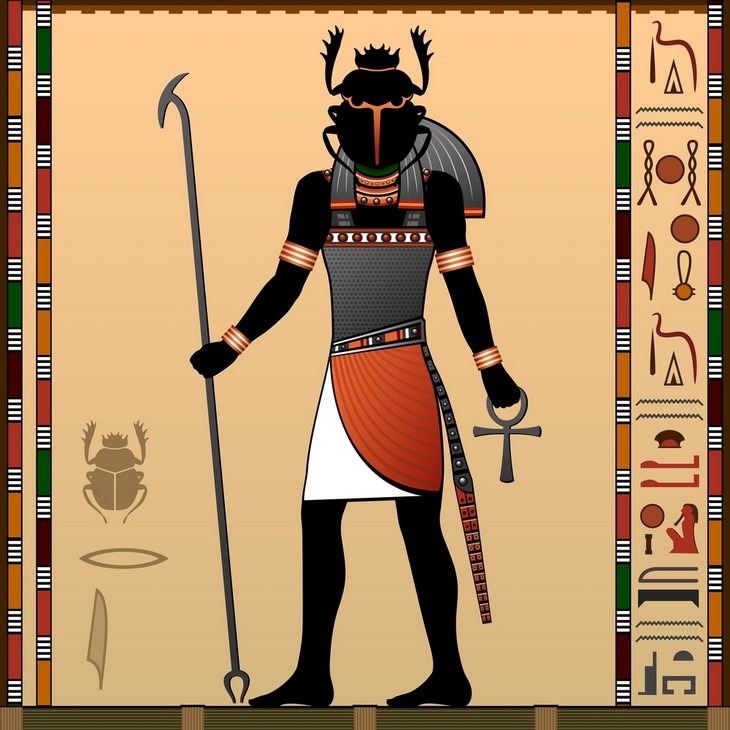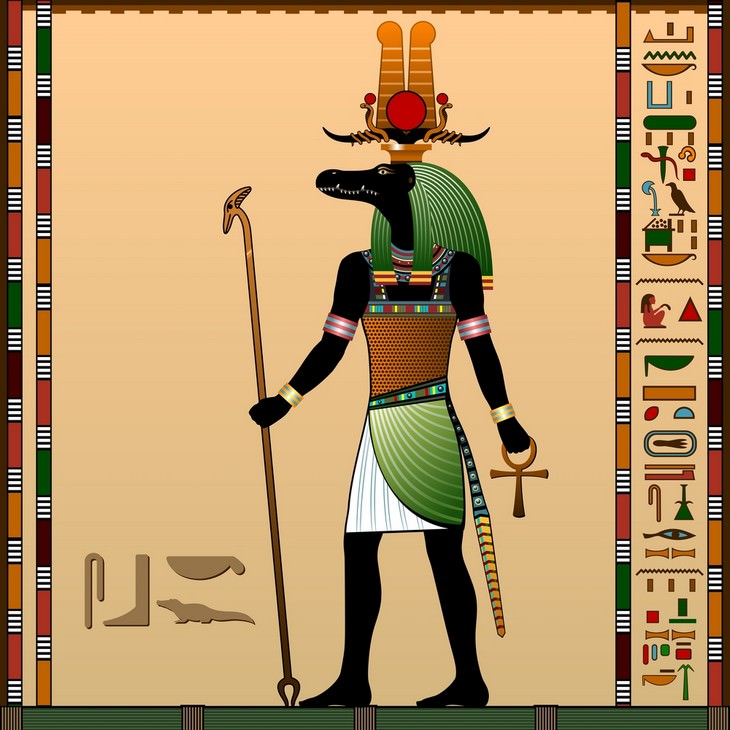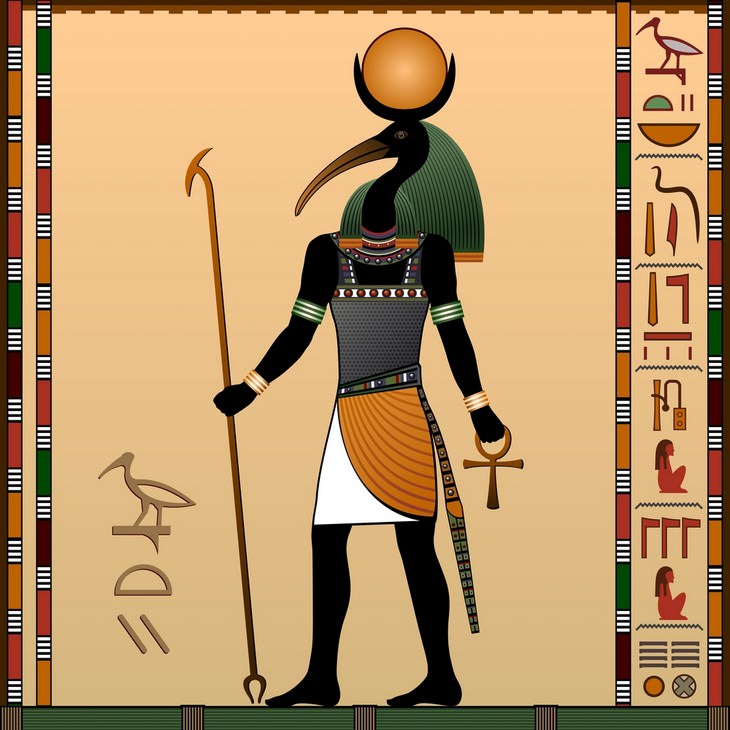Osiris
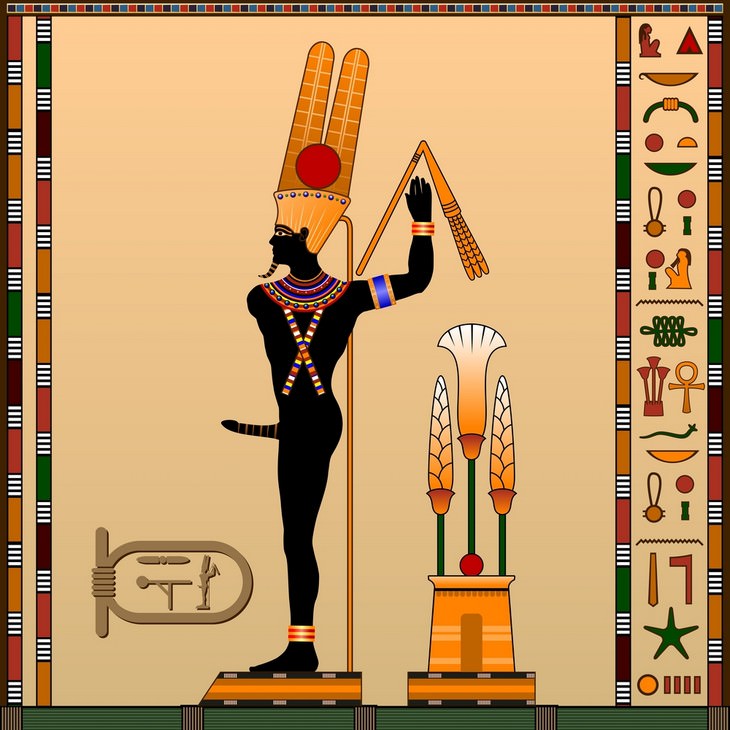
Osiris was the god of fertility, agriculture, the afterlife, the dead, resurrection, life, and vegetation - a busy god. Classically, he is seen as a green-skinned god who has a pharaoh's beard, is partially wrapped like a mummy (his legs) and wearing the symbolic atef crown, holding a symbolic crook and flail.
Osiris was the ruler of the dead and the first god-king of Earth. He is also the god of the moon.
Osiris was murdered by his brother Set (the gods had their own problems, it appears) because he wanted to be the Pharaoh instead of Osiris. According to tales, Osiris was lured into a box by Set, who then poured molted lead on the box, so Osiris was trapped. He then cut Osiris into little pieces. Sure that Osiris was dead and gone, he left.
However, all's well that ends well because his wife, Isis, found all the different pieces and wrapped him up to keep him whole. Sometime later, she brought Osiris back to life. When Horus, their son, was old enough, he fought and defeated Set and became the Pharaoh.
Tidbit: Because Osiris was wrapped to keep him whole, he is also associated with the act of mummification, and it could be that was the origin of the technique (according to Egyptian religion).
Anubis
Anubis is one of the most depicted gods in modern culture, perhaps because he has the head of a Jackal, which is quite a scary sight, or perhaps because he is the keeper of the gates to the lands of the dead, and as such is a very feared yet 'accessible' god, because everyone, when they die, would eventually meet him to be judged. In that respect, he is a bit like St. Peter, only a lot more aloof and alien.
He is known as the god of death, the afterlife, mummification and burial rites. These realms of responsibility were at times taken by other gods. For example, Osiris replaced Anubis as god of the dead.
According to legend, Anubis would weigh the heart of the deceased against the 'Feather of Truth'. If the heart was 'heavy with evil', it would weigh heavier than the feather. If the person was pure of heart, it would be lighter than the feather, buoyed by goodness.
Your fate if you're wicked? You would be eaten by Ammit, also known as 'The Devourer'. Doesn't sound like a great afterlife. But if you are pure of heart, Anubis will step aside and open the door to the next realm of the afterlife, where you get to meet Osiris.
Tidbit: The Greeks and Romans publicly despised the Egyptian gods as barbaric and called Anubis 'The Barker' god, making fun of his animal head. However, they gave him grudging respect and he came to be identified with the Greek god Hermes, creating a mixture god called Hermanubis.
Hathor
Hathor is a goddess and the daughter of Ra. She is the goddess of beautiful and fertile things, such as music, dancing, beauty, love, and fertility. That is why she is also identified with cows, who give milk and life as a mother does, as well as with the Milky Way Galaxy.
Hathor can appear as a human with a horned cow's head. She wore a heavy beaded necklace called a menat. As an animal, she appears again as a cow, with an ankh (a symbol of life). She also has another animal form, that of a fierce lion.
She was known also as the 'Lady of Song', 'Mistress of Maidens' and the 'Golden One', among others. She was a very popular goddess because the mood of the Egyptian people was, in fact, dependent on her. When she was away, the mood became sour and bitter, and when she came back, she brought with her laughter, joy, and beauty.
Tidbit: One might think here is an Egyptian goddess more like the Greek model, but Hathor has a dark past. Before being the goddess of beautiful things, she was a goddess of destruction, known also as Sekmet, who had such a thirst for human blood even Ra's orders to stop eating people wouldn't be enough to stop her.
So Ra, in his cleverness, dyed many barrels of beer red and spilled it across Egypt. When Sekmet saw it, she drank it all, thinking it was human blood. She got drunk and fell into a deep slumber. When she awoke, she did not want to drink human blood anymore (can't blame her, must have been a whopping hangover) and became Hathor. Perhaps, it was to repent for her former deeds that she chose to become a goddess of good things.
Horus
Horus is the son of the god Osiris and the goddess Isis. He is usually depicted with the head of a falcon. In the earlier stages of Egyptian mythology, there were quite a few falcon gods, but with time Horus came to represent all of them. He is considered a handsome god and appears as a falcon-headed man like in the image above, or, in his animal form, as an actual falcon.
Tidbit: Some stories also depict him as a crocodile with the head of a falcon, if you can imagine such a bizarre animal!
Horus was an extremely important god, and the Eye of Horus, also known as Wadjet or Udjat Eye, is a powerful Egyptian symbol of protection, wellbeing, and royal command. According to legend, Horus had a mortal struggle with his uncle Set, brother of Osiris. He lost his eye in this fight, but the eye was not lost. Instead, the magical eye took on a quest of itself. When the other gods tried to catch the powerful eye, the eye began to cry, and its tears became the first people of Egypt. That is why Horus is also known as the King of Egypt.
Khepri
Khepri is a sun god. Although Ra is the main sun god, Khepri is actually believed to be a reincarnation of Ra, and as such, he is the god of rebirth. He is depicted usually as a man with a scarab beetle head, an insect seen as holy in Egyptian religion, and as the dung beetle pushes around its small balls of dung, Khepri was considered to have moved the ball of the sun in its track across the sky.
Along with rebirth, Khepri was also the god of creation, resurrection, and life. The meaning of his name is literally "He who comes into being". The root of the word 'Khepri' also means "to create".
Tidbit: The word for 'transform' and 'create' in Egyptian meant also 'Scarab Beetle'.
Compared to the other gods on this list, Khepri was not as worshipped, and was associated with Ra. However, the scarab amulets that were popular as jewelry by ancient Egyptians represented Khepri, so he was a common symbol.
Khnum
Khnum is one of the most ancient gods in the Egyptian pantheon. He was depicted as a ram-headed man and, according to legend, he was the original source of the Nile River, an incredibly important and powerful presence in Egyptian lives, since it gave them all their power as a nation.
Among other things, Khnum was a god of water, fertility and a 'potter god' of creation. According to legend, he created the first children (not sure what they did before that...) out of clay he took from the banks of the Nile River and put in women's wombs.
He was a powerful creator god, and later stories described him as having created the other gods or molding them. He is also known as 'Divine Potter' and, most impressively, the 'Lord of Created Things From Himself' (A bit long on a calling card). Floods of the Nile were also laid at Khnum's feet, and so the Egyptians probably prayed to him furiously during the rainy winter days, asking him to relent and moderate his fury.
Tidbit: Egyptian children used to invoke him as a protector and called him Khnum-Khufwy, which means 'Khnum is my protector'.
Amun
Amun is another ancient god, among the most ancient, in fact. He was a very powerful god and was often combined with the king god Ra to become the ultimate god Amun-Ra, the most powerful of all incarnations of Ra. In the end, however, he was often combined with the god Horus.
Many researchers believe that the cult of Amun grew so powerful in ancient Egypt that it threatened the main cult of Ra, the biggest cult in Egypt, and that is why these two gods were combined as Amun-Ra, the creator of the universe and the pharaoh's personal protector. He was also known as the god of war.
Amun is thought to have created himself and then creating everything else while remaining separate from the world. In that sense, he is the most ancient creator, the indivisible deity. When shown in human form, he is shown sitting on a throne and wearing a plain deep circlet from which 2 straight plumes, perhaps representing the tail feathers of a bird. As he is a god of wind, that makes a certain symbolic sense.
Tidbit: Amun started as a cult in Thebes, where he was known as the father god, alongside Mut as the mother goddess. Completing the family trio was the moon god Khonsu, their son.
Sobek
Sobek is a crocodile god of the Nile. He is most often depicted as a man with the head of a crocodile. In temples where they worshipped Sobek, they used to keep live crocodiles and feed them in his honor. Sobek was mainly worshipped whenever the Nile was causing problems, either not supplying enough food, not giving good water, flooding or, of course, having too many killer crocodiles.
Because of Sobek, crocodiles were held as holy animals by Egyptians, they would mummify them, treat them as household pets even, and adorn them with anklets and jewels. Egyptians believed that if a crocodile accepted your food, you have pleased Sobek.
Tidbit: When the god Osiris was killed and cut into little pieces, Sobek, being a hungry crocodile god, couldn't help himself but eat a small piece of the god. As punishment, his tongue was cut off, which is why all crocodiles don't have tongues, according to Egyptian folklore.
Thoth
Last, but definitely not least, we come to the god Thoth. Thoth was a deity of scribes and intellectuals. He was said to have been born from the skull of Set and the heart of Ra. According to legend, Thoth was the voice of Ra, translating his indomitable will into words and commands.
It is due to Thoth, according to myth, that we have 365 days and not 360. The story goes that Ra, the god-king, forbade the goddess Nut to have children on any day of the year. Hearing this, wise Thoth went to the moon god Khonsu, son of Amun, and cunningly got him to add 5 more days, known as the 'demon days', when Nut can have children.
His feminine counterpart was a goddess named Seshat. She was also known as the inventor of hieroglyphs, while Thoth taught them. She was also said to be Thoth’s wife or daughter.
TIdbit: There used to be a 5-day celebration for Thoth in Egypt, during the earlier dynasties. They would chant spells and sing hymns in his honor. This kind of thing can get to a god's head!
Related Articles:

